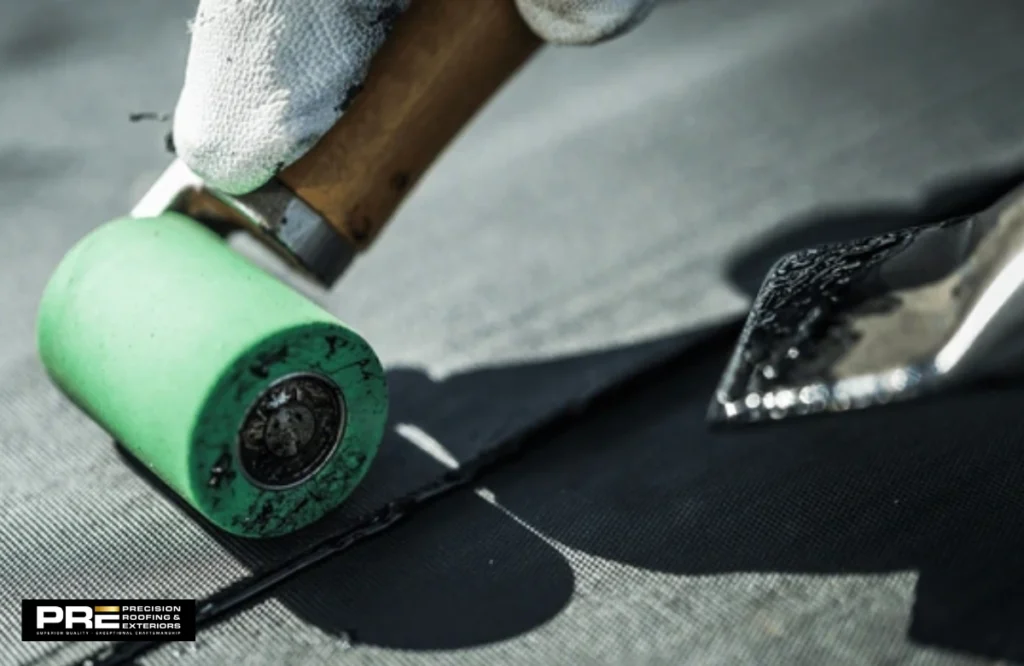If you have a residential or commercial building, you want the roof to last a long time. A rubber roof is a good choice because of its strength and durability. It can last for 40-50 years, depending on how well you maintain it. Rubber roofs can handle tough weather like rain and snow. They also stand up well to the hot sun and heavy wind.
Unlike some other roofs, rubber doesn’t crack or rust easily. That’s why many people choose it when they want a roof that lasts a long time. But how long they last can depend on a few things. The thickness of the rubber matters, as does how the roof was put on. Weather plays a big role, too, as does how many people walk on the roof. Cleaning and checking it from time to time also makes a big difference.
What is a Rubber Roof?
A rubber roof is a roofing system made from synthetic rubber materials like EPDM (ethylene propylene diene monomer), commonly used on flat or low-slope roofs. It’s known for its durability, flexibility, and resistance to weathering. Rubber roofing is a cost-effective and low-maintenance option for both residential and commercial buildings.
The Average Lifespan of a Rubber Roof
Rubber roofs, especially EPDM and TPO types, are known for their impressive durability. Most last between 40 and 50 years when properly installed and maintained. They do not crack or tear easily, withstanding hot days and cool nights. They will not deteriorate fast if regularly cleaned and minor repairs are immediately done.
If the rubber is thick and well-laid, it can be expected to last a longer time. Roofs with frequent human traffic, strong winds, or heavy snow may not be as favorable. Hence, it all depends on the roof’s use and maintenance.
Factors That Affects a Rubber Roof Over Time
Let’s discuss what helps a rubber roof last long and what doesn’t.
Type of Rubber Used
There are two main types. One is EPDM, which is black and lasts longer. The other is TPO, which is white and helps keep buildings cool. EPDM can last 40–50 years, while TPO usually lasts 20–30 years.
Rubber Thickness
An important reason rubber roofs stay sound for years is plain-old thickness. The extra heft gives the membrane more muscle. We usually talk about thickness in millimeters. A 90-mm layer will outlast a 60-mm layer almost every time. Thicker rubber shrugs off sun, rain, and wind that would wear thinner stuff out. Picture a stout rubber band: bend or stretch it all day, yet it holds. That same logic applies to your entire rooftop.
Installation Quality
If the roof is installed correctly, it will stay strong. If it is not done well, water can get inside, causing leaks. Leaks weaken the roof and shorten its life.
Weather Condition
If it rains a lot where you live, or if there is snow and wind, the roof can get damaged. The sun can also make the rubber hot every day, which can cause the roof to wear out over time.
Too Much Foot Traffic
Walking on the roof too much can hurt it. Shoes can scratch the rubber or make small cuts. Try not to walk on the roof unless you need to.
Standing Water
Water should run off the roof. If it stays in puddles, it can cause problems. Get help if the water doesn’t drain.
Maintenance Practices
If you check your roof often, it will last longer. You can see if something is wrong and fix it early, which helps prevent bigger problems later.
Easy Tips to Help Your Rubber Roof Last Even Longer
You can help your rubber roof stay strong. Here are some easy ways to do that:
- Check the Roof Every Year to Catch Problems Early: Look at your roof at least once a year. Look for cracks, holes, or anything strange. You should also check after storms. It only takes a few minutes, but can save you from big problems later.
- Fix Small Problems Before They Get Worse: Don’t ignore small issues. A tiny crack today can lead to leaks tomorrow. Use a patch kit or call a professional as soon as you notice damage to keep costs low and protect your roof.
- Keep the Roof Clean So Dirt Doesn’t Build Up: Clean your rubber roof a few times a year to remove leaves, dirt, and debris. Use mild soap, water, and a soft brush. Avoid harsh chemicals or power washers, as they can damage the membrane.
- Reduce Walking on the Roof: Try not to walk on your roof unless you have to. If people walk on it often, put strong pads where they step. This helps protect the rubber. Too much walking can wear it down and cause damage over time.
- Be Gentle with Tools and Sharp Things: If you take tools on the roof, be gentle. Don’t drop or drag them. Sharp tools can cut the rubber. Once gravity gets involved, even a pinhole tear can spill water inside.
- Trim Overhanging Branches: Branches that hang too low can scratch the roof. Cut them back so they don’t rub against the rubber when the wind blows. This helps keep leaves and debris from piling up on the roof.
Conclusion
Rubber roofs are a smart and long-lasting choice for commercial buildings and homes. They’re lightweight, durable, and easy to repair. While they typically last 40 to 50 years, their lifespan depends on factors like installation quality, climate, and regular maintenance.
With just a little care, like routine cleaning and inspections, you can help your rubber roof stay in shape for decades. Want to extend the lifespan of your roof? Contact Professional roofing contractors like Precision Roofing today for expert rubber roof installation and maintenance.

